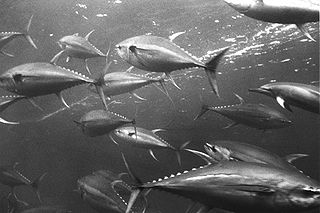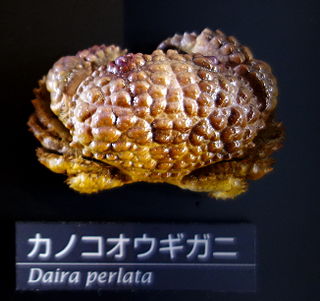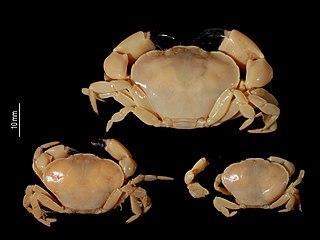
The mackerel, tuna, and bonito family, Scombridae, includes many of the most important and familiar food fishes. The family consists of 51 species in 15 genera and two subfamilies. All species are in the subfamily Scombrinae, except the butterfly kingfish, which is the sole member of subfamily Gasterochismatinae.

The mousebirds are birds in the order Coliiformes. They are the sister group to the clade Cavitaves, which includes the Leptosomiformes, Trogoniformes (trogons), Bucerotiformes, Piciformes and Coraciformes. This group is now confined to sub-Saharan Africa, and it is the only bird order confined entirely to that continent, with the possible exception of turacos which are considered by some as the distinct order Musophagiformes, and the cuckoo roller, which is the only member of the order Leptosomiformes, and which is found in Madagascar but not mainland Africa. Mousebirds had a wider range in the Paleogene, with a widespread distribution in Europe and North America during the Paleocene.

Xanthidae is a family of crabs known as gorilla crabs, mud crabs, pebble crabs or rubble crabs. Xanthid crabs are often brightly coloured and are highly poisonous, containing toxins which are not destroyed by cooking and for which no antidote is known. The toxins are similar to the tetrodotoxin and saxitoxin produced by puffer fish, and may be produced by bacteria in the genus Vibrio living in symbiosis with the crabs, mostly V. alginolyticus and V. parahaemolyticus.

Pipunculidae is a family of flies (Diptera) commonly termed big-headed flies, a reference to the large (holoptic) eyes, which cover nearly the entire head. The family is found worldwide and more than 1300 species have been described.

Quercygale is an extinct genus of placental mammals from the clade Carnivoraformes, that lived in Europe during the early to late Eocene.
Eochelone is an extinct genus of sea turtle from the late Eocene. It was first named by Dollo in 1903. Its type species is E. brabantica.
Arabemys is an extinct genus of sea turtle. It was first named in 1999, and contains one species, A. crassiscutata. It is known from deposits of Late Paleocene or Early Eocene age near the village of Linah in northern Saudi Arabia.

Cynthiacetus is an extinct genus of basilosaurid early whale that lived during the Late Eocene Specimens have been found in the southeastern United States and Peru.
Tanaocheles is a genus of crabs, the only genus in the family Tanaocheleidae. It contains two species, T. bidentata and T. stenochilus. The two species were formerly placed in different families, and they were only shown to be related, and placed in a new subfamily, in 2000.

Dairoidea is a superfamily of crabs, comprising two families which each contain a single genus: Dairidae and Dacryopilumnidae (Dacryopilumnus) .

Xantho is a genus of crabs in the family Xanthidae, containing five extant species, all restricted to the north-east Atlantic Ocean and Mediterranean Sea, although Xantho granulicarpis is not universally recognised as a separate species from Xantho hydrophilus:

Polydectus cupulifer is a species of crab in the family Xanthidae, and the only species in the genus Polydectus. Together with the genus Lybia, it forms the subfamily Polydectinae. It is found in the Indo-Pacific, ranging from Madagascar and the Red Sea in the west to Japan, Hawaii and French Polynesia in the east. P. cupulifer is densely covered with setae (bristles), and frequently carries a sea anemone in each chela (claw).

Demania is a genus of crabs in the family Xanthidae, containing the following species:

Euryxanthops is a genus of crabs in the family Xanthidae. It was originally established in 1983 by Garth & Kim to contain three species of deep-water crabs from Japan and the Philippines - Euryxanthops dorsiconvexus, Euryxanthops flexidentatus and Euryxanthops orientalis. Since then, several more species of this genus have been identified and described, and Euryxanthops currently contains:
Marratha angusta is a species of crabs in the family Xanthidae, the only species in the genus Marratha. It was originally described as Cycloxanthops angustus by Mary J. Rathbun in 1906, but was moved to a new genus in 2003; the name of the genus, Marratha, is an "arbitrary abbreviation" of Rathbun's name. It has been recorded from the Amirante Islands (Seychelles), Hawaii and the South China Sea.
Phlyctenodes is an extinct genus of crabs in the family Xanthidae, containing the following fossil species:

Rizalthus is a genus of crabs in the family Xanthidae. The only species in the genus is Rizalthus anconis.
Visayax is a genus of crabs in the family Xanthidae, containing the following species:

Afrotarsius is a primate found in the Paleogene of Africa.
Orienspterodon is an extinct genus of hyainailourid hyaenodonts from paraphyletic subfamily Hyainailourinae that lived in China and Myanmar during the middle to late Eocene. Orienspterodon dahkoensis was originally assigned to genus Pterodon in 1975, but was eventually assigned to its own genus in 2007.











